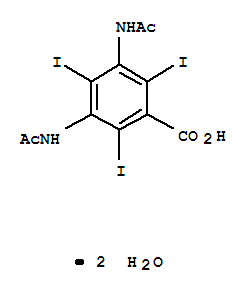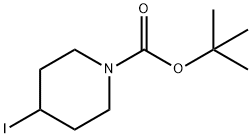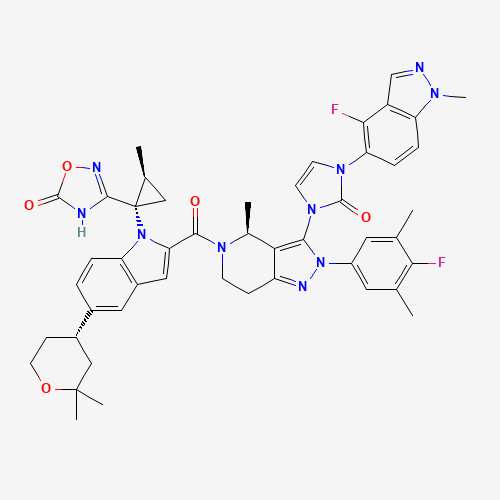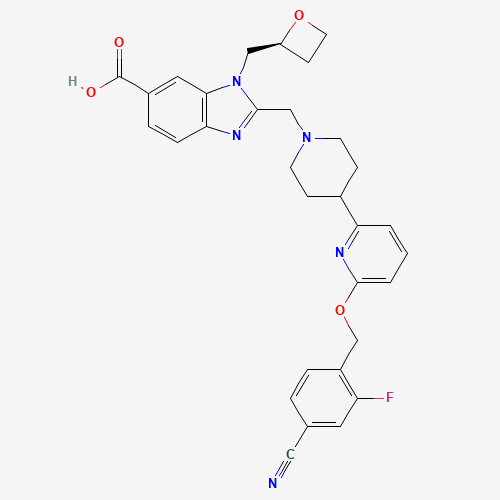
50978-11-5
- Product Name:Diatrizoic Acid
- Molecular Formula:C11H9I3N2O4·2H2O
- Purity:99%
- Molecular Weight:613.92
Product Details:
CasNo: 50978-11-5
Molecular Formula: C11H9I3N2O4·2H2O
Chinese Manufacturer Supply Diatrizoic Acid,Sale 50978-11-5 Lowest Price
- Molecular Formula:C11H9I3N2O4·2H2O
- Molecular Weight:613.92
- Vapor Pressure:6.19E-16mmHg at 25°C
- Refractive Index:1.802
- Boiling Point:614.1°C at 760 mmHg
- PKA:pKa 3.4 (Uncertain)
- Flash Point:325.2°C
- PSA:113.96000
- Density:2.619g/cm3
- LogP:3.13280
Diatrizoic Acid Dihydrate(Cas 50978-11-5) Usage
|
Description |
Diatrizoic acid is chemically known as 3,5-di-acetamido-2,4,6-triiodobenzoic acid. It is a white, odorless, and tasteless crystalline powder. Various formulations of diatrizoic acid exist, including its sodium salt and methylglucamine salt, each with different properties such as taste and solubility. |
|
Uses |
Diatrizoic acid serves as an alternative to barium sulfate for imaging the gastrointestinal tract, including upper gastrointestinal series and small bowel series. It is used when patients are allergic to barium or when there is a risk of barium leakage into the abdominal cavity. Besides medical imaging, diatrizoic acid is also utilized as a gradient reagent for blood cell separation and as a diagnostic aid, particularly as a radiopaque medium. |
|
Definition |
ChEBI: The dihydrate form of amidotrizoic acid. Both the dihydrate and the anhydrous form are used as X-ray contrast media. |
InChI:InChI=1S/C11H9I3N2O4/c1-3(17)15-9-6(12)5(11(19)20)7(13)10(8(9)14)16-4(2)18/h1-2H3,(H,15,17)(H,16,18)(H,19,20)
50978-11-5 Relevant articles
Elimination of radiocontrast agent Diatrizoic acid from water by electrochemical advanced oxidation: Kinetics study, mechanism and mineralization pathway
Elvira Bocos a b, Nihal Oturan a, M. Ángeles Sanromán b, Mehmet A. Oturan a
Journal of Electroanalytical Chemistry Volume 772, 1 July 2016, Pages 1-8
The complete mineralization of the X-ray agent contrast Diatrizoic acid in aqueous medium was studied by EF processes with BDD anode under different catalyst concentration and applied current values.
Insights into the Crystallisation Process from Anhydrous, Hydrated and Solvated Crystal Forms of Diatrizoic Acid
Dr. Katharina Fucke, Dr. Garry J. McIntyre, Dr. Marie-Hélène Lemée-Cailleau, Dr. Clive Wilkinson, Dr. Alison J. Edwards, Prof. Judith A. K. Howard, Prof. Jonathan W. Steed
, A European Journal,Volume21, Issue3 January 12, 2015 Pages 1036-1047
Diatrizoic acid crystallises in two hydrated, three non-solvated and nine solvated crystal forms. The ultrastable hydrogen-bonded dihydrate capsule does not allow for halogen bonding, whilst all solvated forms show this interaction. Several crystal packing motifs reveal overall similar supramolecular interactions.
Relevant Products
-
N-Boc-4-iodopiperidine
CAS:301673-14-3
-
Orforglipron
CAS:2212020-52-3
-
Danuglipron
CAS:2230198-02-2








